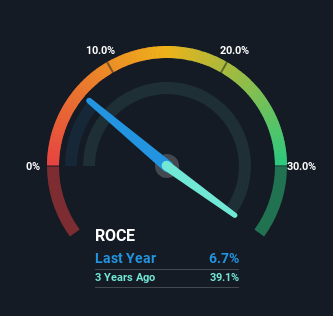- Hong Kong
- /
- Consumer Durables
- /
- SEHK:2381
The Returns On Capital At SMC Electric (HKG:2381) Don't Inspire Confidence
What are the early trends we should look for to identify a stock that could multiply in value over the long term? Ideally, a business will show two trends; firstly a growing return on capital employed (ROCE) and secondly, an increasing amount of capital employed. Basically this means that a company has profitable initiatives that it can continue to reinvest in, which is a trait of a compounding machine. Although, when we looked at SMC Electric (HKG:2381), it didn't seem to tick all of these boxes.
Understanding Return On Capital Employed (ROCE)
For those who don't know, ROCE is a measure of a company's yearly pre-tax profit (its return), relative to the capital employed in the business. The formula for this calculation on SMC Electric is:
Return on Capital Employed = Earnings Before Interest and Tax (EBIT) ÷ (Total Assets - Current Liabilities)
0.067 = HK$10m ÷ (HK$197m - HK$45m) (Based on the trailing twelve months to June 2023).
So, SMC Electric has an ROCE of 6.7%. On its own that's a low return on capital but it's in line with the industry's average returns of 7.1%.
Check out our latest analysis for SMC Electric

Historical performance is a great place to start when researching a stock so above you can see the gauge for SMC Electric's ROCE against it's prior returns. If you're interested in investigating SMC Electric's past further, check out this free graph of past earnings, revenue and cash flow.
The Trend Of ROCE
When we looked at the ROCE trend at SMC Electric, we didn't gain much confidence. To be more specific, ROCE has fallen from 36% over the last five years. And considering revenue has dropped while employing more capital, we'd be cautious. If this were to continue, you might be looking at a company that is trying to reinvest for growth but is actually losing market share since sales haven't increased.
On a side note, SMC Electric has done well to pay down its current liabilities to 23% of total assets. That could partly explain why the ROCE has dropped. What's more, this can reduce some aspects of risk to the business because now the company's suppliers or short-term creditors are funding less of its operations. Since the business is basically funding more of its operations with it's own money, you could argue this has made the business less efficient at generating ROCE.
The Key Takeaway
In summary, we're somewhat concerned by SMC Electric's diminishing returns on increasing amounts of capital. Yet despite these concerning fundamentals, the stock has performed strongly with a 30% return over the last three years, so investors appear very optimistic. Regardless, we don't feel too comfortable with the fundamentals so we'd be steering clear of this stock for now.
If you'd like to know more about SMC Electric, we've spotted 4 warning signs, and 1 of them doesn't sit too well with us.
While SMC Electric isn't earning the highest return, check out this free list of companies that are earning high returns on equity with solid balance sheets.
New: Manage All Your Stock Portfolios in One Place
We've created the ultimate portfolio companion for stock investors, and it's free.
• Connect an unlimited number of Portfolios and see your total in one currency
• Be alerted to new Warning Signs or Risks via email or mobile
• Track the Fair Value of your stocks
Have feedback on this article? Concerned about the content? Get in touch with us directly. Alternatively, email editorial-team (at) simplywallst.com.
This article by Simply Wall St is general in nature. We provide commentary based on historical data and analyst forecasts only using an unbiased methodology and our articles are not intended to be financial advice. It does not constitute a recommendation to buy or sell any stock, and does not take account of your objectives, or your financial situation. We aim to bring you long-term focused analysis driven by fundamental data. Note that our analysis may not factor in the latest price-sensitive company announcements or qualitative material. Simply Wall St has no position in any stocks mentioned.
About SEHK:2381
SMC Electric
An investment holding company, manufactures and sells electric tools and fans in the Americas, Asia, Oceania, Europe, and Africa.
Flawless balance sheet with proven track record.
Market Insights
Community Narratives



